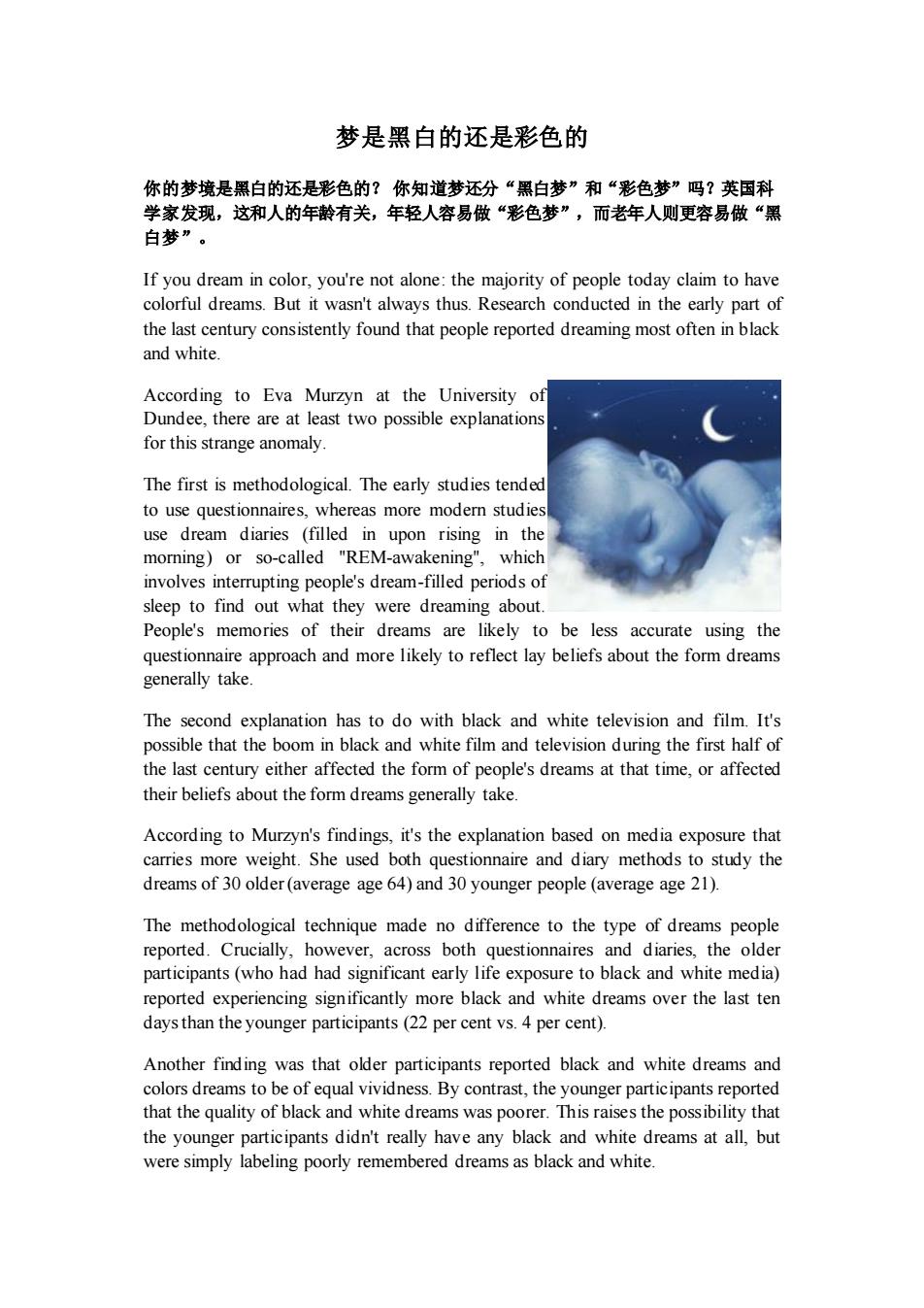
梦是黑白的还是彩色的 你的梦境是黑白的还是彩色的?你知道梦还分“黑白梦”和“彩色梦”吗?英国科 学家发现,这和人的年龄有关,年轻人容易做“彩色梦”,而老年人则更容易做“黑 白梦”。 If you dream in color,you're not alone:the majority of people today claim to have colorful dreams.But it wasn't always thus.Research conducted in the early part of the last century consistently found that people reported dreaming most often in black and white According to Eva Murzyn at the University Dundee,there are at least two possible explanations for this strange anomaly. The first is methodological.The early studies tended to use questionnaires,whereas more modern studies use dream diaries (filled in upon rising in the morning)or so-called "REM-awakening",which involves interrupting people's dream-filled periods of sleep to find out what they were dreaming about. People's memories of their dreams are likely to be less accurate using the questionnaire approach and more likely to reflect lay beliefs about the form dreams generally take. The second explanation has to do with black and white television and film.It's possible that the boom in black and white film and television during the first half of the last century either affected the form of people's dreams at that time,or affected their beliefs about the form dreams generally take. According to Murzyn's findings,it's the explanation based on media exposure that carries more weight.She used both questionnaire and diary methods to study the dreams of 30 older(average age 64)and 30 younger people (average age 21). The methodological technique made no difference to the type of dreams people reported.Crucially,however,across both questionnaires and diaries,the older participants (who had had significant early life exposure to black and white media) reported experiencing significantly more black and white dreams over the last ten days than the younger participants(22 per cent vs.4 per cent). Another finding was that older participants reported black and white dreams and colors dreams to be of equal vividness.By contrast,the younger participants reported that the quality of black and white dreams was poorer.This raises the possibility that the younger participants didn't really have any black and white dreams at all,but were simply labeling poorly remembered dreams as black and white
梦是黑白的还是彩色的 你的梦境是黑白的还是彩色的? 你知道梦还分“黑白梦”和“彩色梦”吗?英国科 学家发现,这和人的年龄有关,年轻人容易做“彩色梦”,而老年人则更容易做“黑 白梦”。 If you dream in color, you're not alone: the majority of people today claim to have colorful dreams. But it wasn't always thus. Research conducted in the early part of the last century consistently found that people reported dreaming most often in black and white. According to Eva Murzyn at the University of Dundee, there are at least two possible explanations for this strange anomaly. The first is methodological. The early studies tended to use questionnaires, whereas more modern studies use dream diaries (filled in upon rising in the morning) or so-called "REM-awakening", which involves interrupting people's dream-filled periods of sleep to find out what they were dreaming about. People's memories of their dreams are likely to be less accurate using the questionnaire approach and more likely to reflect lay beliefs about the form dreams generally take. The second explanation has to do with black and white television and film. It's possible that the boom in black and white film and television during the first half of the last century either affected the form of people's dreams at that time, or affected their beliefs about the form dreams generally take. According to Murzyn's findings, it's the explanation based on media exposure that carries more weight. She used both questionnaire and diary methods to study the dreams of 30 older (average age 64) and 30 younger people (average age 21). The methodological technique made no difference to the type of dreams people reported. Crucially, however, across both questionnaires and diaries, the older participants (who had had significant early life exposure to black and white media) reported experiencing significantly more black and white dreams over the last ten days than the younger participants (22 per cent vs. 4 per cent). Another finding was that older participants reported black and white dreams and colors dreams to be of equal vividness. By contrast, the younger participants reported that the quality of black and white dreams was poorer. This raises the possibility that the younger participants didn't really have any black and white dreams at all, but were simply labeling poorly remembered dreams as black and white